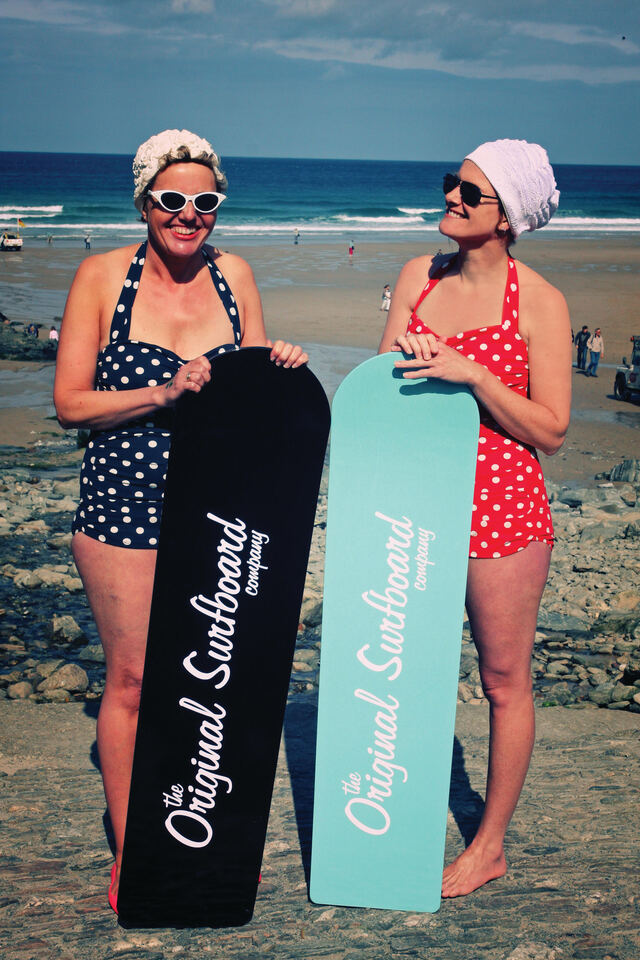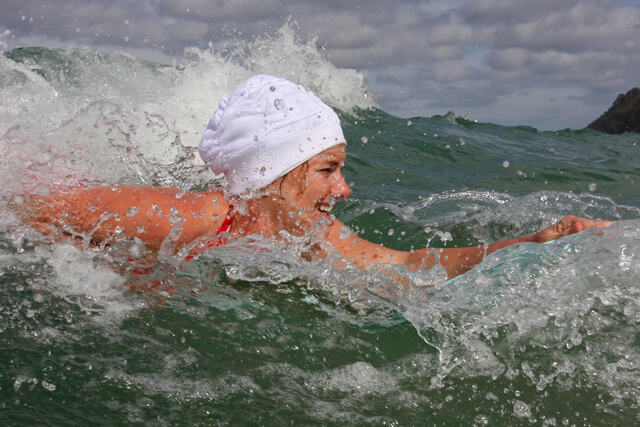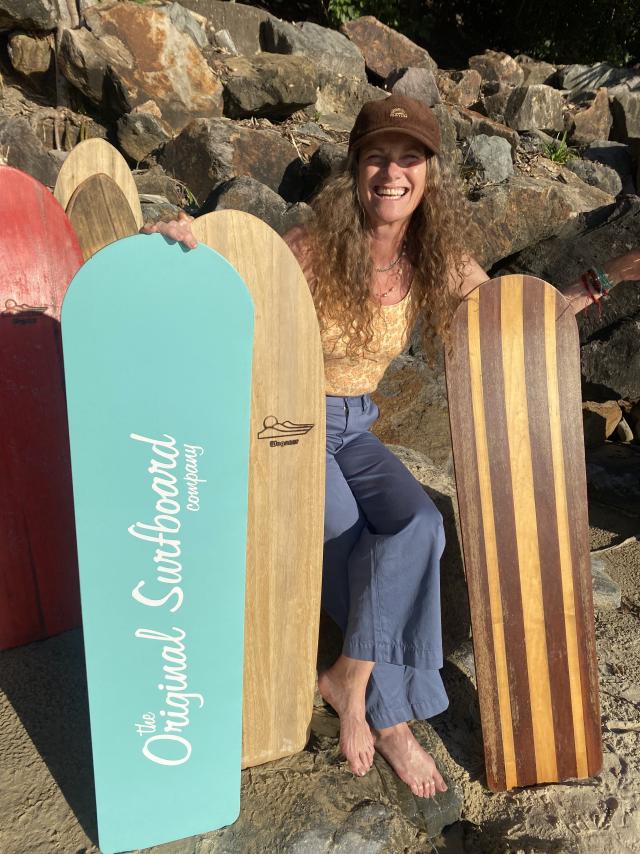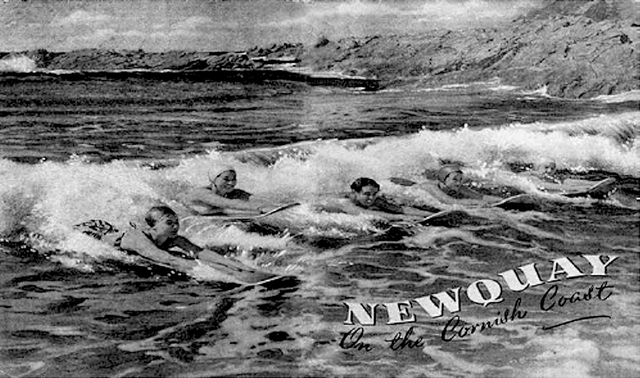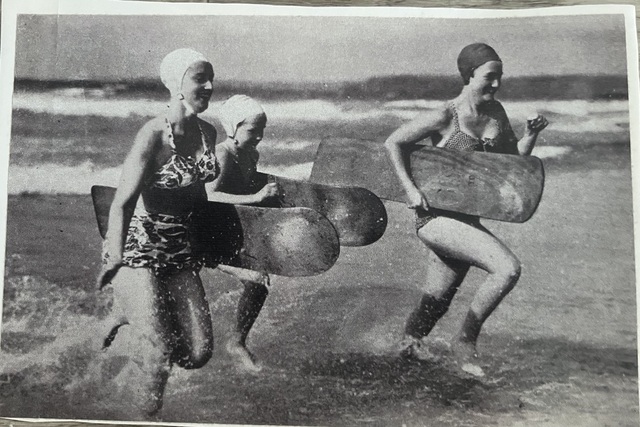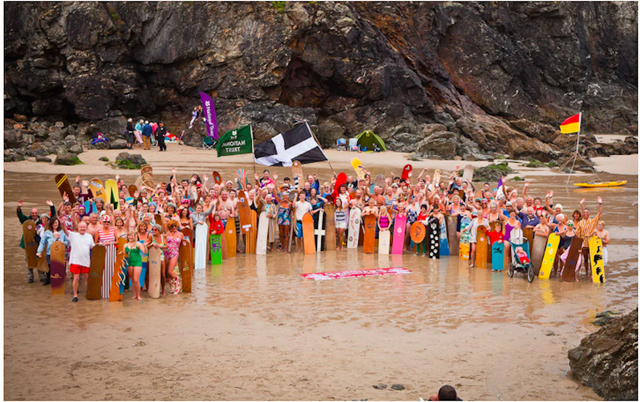When Margie Wegener heads off to chilly Cornwall in September to represent Australia (and Noosa, of course) at the World Bellyboard Championships at Great Western Beach in Newquay, apart from enjoying all the fun of this historic and eccentric event, she means to bring home the trophy.
What are her chances? Well, apart from the fact that few non-Poms have ever won the WBC in the 20 years since its inception, the Wegeners have form, with son Finley, very much under-aged and undersized in the Under 18 Juniors division, taking out the world title in 2009. “If Fin can do it, I can do it,” Margie laughed this week. “He didn’t even train for it, whereas I’m down at Castaways every day, without a wetsuit, getting acclimatised for the cool Cornish summer.”
Although the Newquay event was in its infancy when the Wegener family last attended, it had been inspired by a century-old tradition of summer sliding along the Cornish and Devon coasts, and renowned surfboard artisan Tom Wegener, now a Noosa councillor, had long been fascinated by surfing’s prone wood board roots around the world, so the World Bellyboard Championships was a revelation in many ways.
Says Margie: “It was so different to any surf comp we’d ever been to. It had a real community vibe about it. Because it can be quite cold, people tend to put a few layers on for the beach, but they also dress up a bit in the style of the sport’s pioneers a century ago, wearing three-piece suits and so on. They had a beer sponsor in 2009, so there was a keg on the beach under this big old army tent with wooden tables groaning with sandwiches. They had a ladies’ cake competition and they’d bring them down to the beach, and also flasks of hot tea because you’re not allowed to wear a wetsuit. You can wear woollens like they did back in the day, but the competitors come out of the water freezing, and there’s nothing better than a hot cuppa.”
While the wood belly board can be traced back to Hawaii and Polynesia (where they were known as “paipos”) in the 18th century, by the start of the 20th century their use had spread to many other parts of the world, including Australia, where imported South Sea Islander labourers would fashion them from fallen trees and ride them in the surf. But the British Empire also played a role in sharing the stoke around its many outposts. As Tom Wegener noted in his 2016 PhD thesis and book Surfboard Artisans: “The wood bodyboard was enormously popular in Cornwall and Devon for the first half of the 20th century. Many hardcore surfers would pack up the family and head to the beach for the summer to get as many waves as they could. Oral tradition has it that the boards started out literally as coffin lids that stoked surfers would wade out into the surf and ride in on their bellies.”
Margie sees the proof of that even today: “I was surfing my Cornish-style “Original” at Castaways the other day when I was stopped by a 75-year-old woman who was gobsmacked because she hadn’t seen one like that since she was in Sri Lanka as a little girl!”
By the roaring ‘20s, British bellyboarding was a big deal, with a Newquay travel guide for 1921 showing the happy throng shivering shoreward, and the bellyboard culture survived even beyond the introduction of the Malibu stand-up surfboard by Australian lifeguards in the 1960s.
The story of how the World Bellyboard Championships came to be typifies the resilient spirit of British surfing, as writer Luke Gartside notes on the WBC website: “It starts with a group of unassuming holidaymakers who would meet up every year on the same week in September and go bellyboarding at Chapel Porth beach. They hailed from all corners of the country, but each shared a deep fondness for riding waves, fostered over many decades of trips to the Cornish seaside. Among them was Arthur Traveller, a London-based mechanic, who would travel down each year with his elderly mother. Every day at the crack of dawn, no matter the weather or sea conditions, the group would head for the beach.”
Sadly, when the friends began to plan their 2003 bellyboard blitz, they discovered that Arthur had passed away after a heart attack. They decided to honour him with a small memorial contest at Chapel Porth. It was well attended and well reported, and the next year someone had the bright idea of calling it the world championships. In 2004 it blew up!
By the time the Wegeners arrived for the sixth running, the WBC had been featured on Sky Sports and was attracting so many competitors and spectators that the organisers had to start thinking about moving to a bigger beach, but its folksy roots were still very much alive, as Margie recalls: “We met a lady named Sally Parkin, who kindly invited us to stay at her family home at the beach. We quickly became best friends and learned that she was one of the people behind the resurgence of wood bellyboards. She was putting her efforts into getting the support of the National Trust, to have them put some of their money and energy into the history of it.
As Tom later wrote in Surfboard Artisans: “In 2007 Sally Parkin attended the event for the first time and it was life-changing. She found that there were many others who enjoyed the wood belly boards just like she had since she started riding them on summer holidays at the age of five. There were racks of old boards on the beach and various competitions including best art [on a board] and best vintage bathing suit and she was thrilled to discover that
a company in North Devon that still made the plywood boards she had grown up with.”
After the 2007 WBC Sally sought out the elderly owner, Dick Pearce, who explained that he’d sold his boards all along the coast into the ‘70s, but “no one wants them anymore”. Sally, whose professional background was in advertising and marketing, believed she could bring them back in a way that would be appealing to all age groups. Thus was born The Original Surfboard Company.
When Margie Wegener hits the cold water of Cornwall in September with her friend Sally by her side, both of them shivering in polka dot period one-pieces and bathing caps, they’ll have a favourite Original proudly tucked under their arms, ready to push off the sandbank into the first wave that presents itself, ahead of a nice hot cuppa and a piece of cake.

